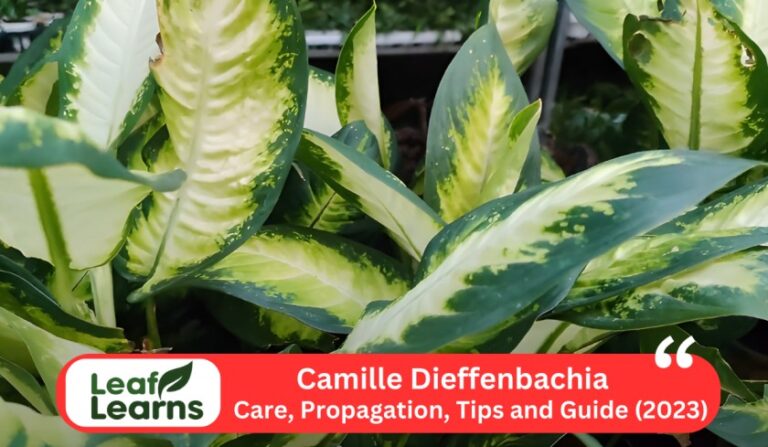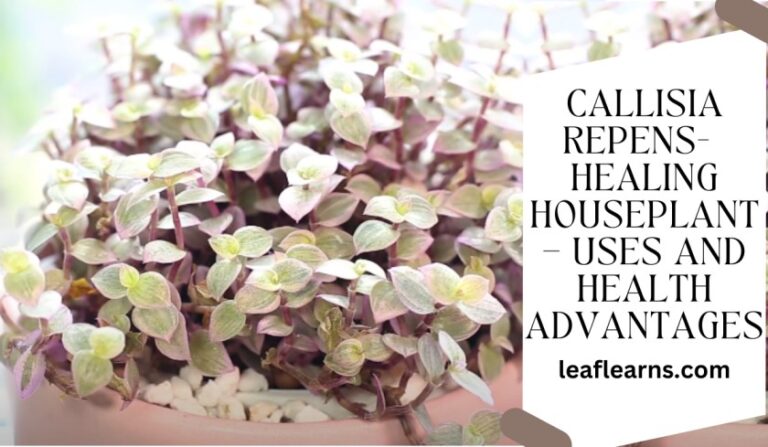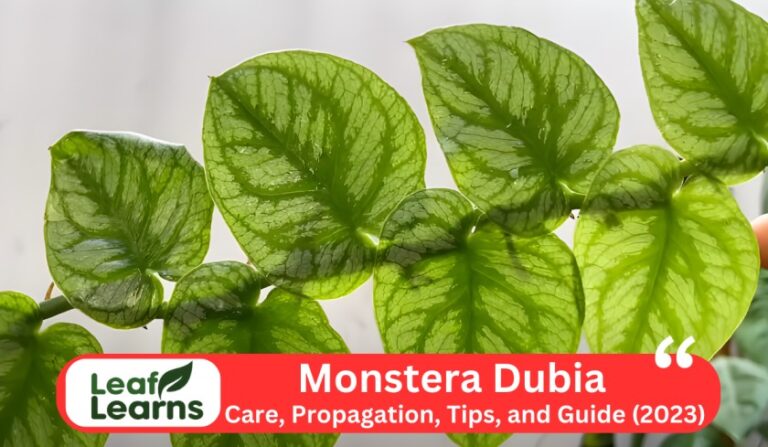Calathea WhiteStar Care, Propagation, Tips Info(2023)
The Calathea Whitestar, scientifically called Calathea majestica. This plant belongs to the Marantaceae family and is present and originates from the tropical regions of South America. This plant is a type of plant which is clumping herbaceous perennial that typically reaches a height of 12-24 inches (30-60 cm) when grown indoors and makes it beautiful in the room.
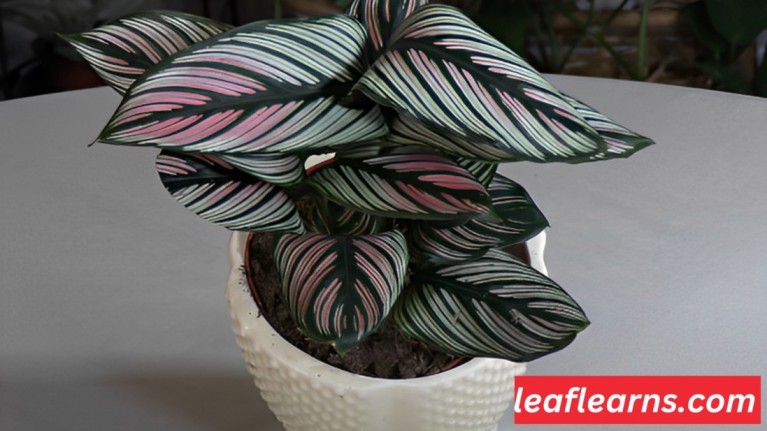
Its leaves are broad and elliptical and a dark green color present on the leaves and prominent veins. It can grow in temperatures between 65-80°F (18-27°C) and take high humidity like 50%.
When we talk about the propagation method which is different and you propagate it easily by different methods like division or stem cuttings. For best growth, provide the best bright, indirect light and use a organic matter and well-drained potting mix soil which is better for the plant’s health and performance.
This plant can take small amount of water to keep the soil moist. While for pests like spider mites, mealybugs, and aphids. Fortunately, this plant is non-toxic to both humans and pets. The plant’s gorgeous foliage, which has eye-catching white stripes, and its leaves, which unfold in the morning after folding upward at night, are its finest unique characteristic.
| Common name | Calathea Whitestar |
| Scientific Name | Calathea majestica |
| Family | Marantaceae |
| Distribution | Tropical regions of South America |
| Plant type | Clumping, herbaceous perennial |
| Size | 12-24 inches (30-60 cm) in height indoors |
| Leaf Colour | Dark green with prominent veins |
| Leave | Broad, elliptical, dark green leaves |
| Temperature | 65-80°F (18-27°C) |
| Humidity | High humidity preferred, 50% or higher |
| Propagations | Division or stem cuttings |
| Light requirement | Bright, indirect light |
| Soil requirement | Well-draining potting mix rich in organic matter |
| Watering Need | Small amounts of water on a regular basis |
| Pests | Spider mites, mealybugs, and aphids |
| Toxicity | Non-toxic to humans and pets |
| Special feature | Attractive foliage with striking white stripes; leaves fold upward at night and unfurl in the morning |
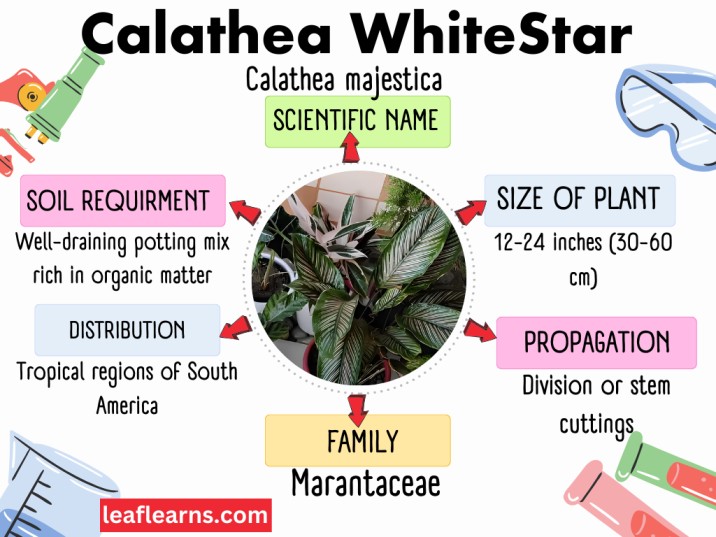
Contents
- 1 3 Care Tips for Calathea-WhiteStar
- 2 Care for Calathea Whitestar
- 3 Best Location for growing
- 4 Potting Requirements
- 5 Growth Habits
- 6 How to Prune
- 7 What To Do When You First Get Your Calathea WhiteStar
- 8 Propagation for Calathea Whitestar
- 9 Growth Rate
- 10 Repotting
- 11 Common Problems And Solution
- 12 Overwatering or Underwatering
- 13 Toxicity
- 14 Pests
- 15 Disease
- 16 Wilting or Drooping Leaves
- 17 Calathea WhiteStar Care and Maintenance
- 18 Calathea White Star Care Considerations in Different Regions
- 19 Conclusion
- 20 FAQs
3 Care Tips for Calathea-WhiteStar
- Calathea-WhiteStar like its soil to be continuously wet but not drenched in moisture. When the top inch of soil seems dry, water it. Don’t allow the plant sit in standing water; instead, use a saucer underneath the container to collect any extra moisture.
- Best Lighting: This plant enjoys direct, strong light. Avoid the sun’s direct rays since they might burn the foliage. Put it in a room with filtered light or close to a window with a sheer curtain.
- Keep the Humidity Up: It prefers a humid atmosphere. Use a humidity tray or often spritz the leaves with water to keep it content. Additionally, you may put your plants in groups to create a microclimate with a greater humidity level.
Care for Calathea Whitestar
How much water needed
This plant doesn’t like to be swimming in water but prefers to be continually wet. It’s similar to Goldilocks’ porridge in that it is the perfect amount of wet and dry. When the top inch of soil seems dry to the touch, you should water it.

If the soil is dry at that depth, stick your finger in it and give it some water. However, take care not to overdo it since too much water will upset the roots. Just keep in mind that finding the ideal balance for your Calathea White Star just takes a little patience and the occasional finger test.
Light requirement
Light is something Calathea-WhiteStar enjoys, but not too much or too little. Consider it this way: it’s similar to Goldilocks’ quest for the ideal balance. It desires direct, strong light. It should thus be situated adjacent to a window so that it receives some light but not direct sunlight.
Because the sun’s glaring rays might damage its leaves, a curtain or some additional space away from the window acts as a cosy, shaded area for the plant. So keep in mind: just right means neither too light nor too dark.
Soil requirement
Like an excellent sponge, Calathea-WhiteStar like its soil to be well-draining and rather fluffy. To do this, a blend of potting soil and perlite or orchid bark works nicely.
By doing this, the roots are kept out of water, which benefits their happiness. The top inch of soil should dry out in between waterings, and the earth should be uniformly wet but not soggy. It’s like giving your plant a comfortable, open home where its roots may flourish.
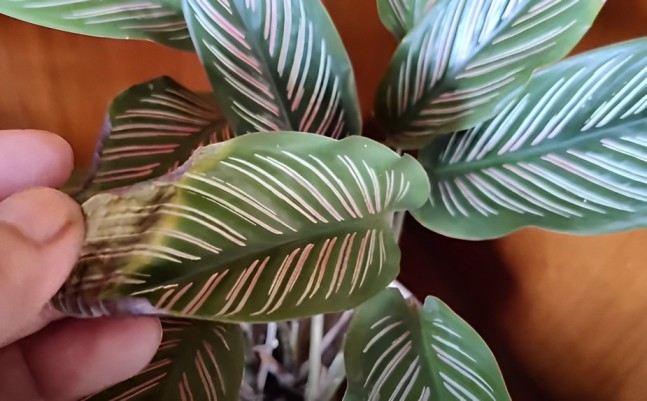
Temperature requirement
Like you, Calathea plant enjoys being warm and cosy on her cosy blanket. The ideal temperature range for it is between 65°F and 75°F (18°C and 24°C). As a result, keep it free from chilly droughts and sharp temperature changes to ensure its happiness and health.
Humidity requirement
The Calathea-WhiteStar enjoys high humidity like a plant spa aficionado. Imagine it as a plant that appreciates a little humidity, much as how we like a humidifier in a dry space. Every few days, sprinkle the plant’s leaves with a spray bottle to keep it happy.
You may also put a tray of water and stones close to the plant to create a mini-humid atmosphere. Consider placing your Calathea White Star in a bathroom or combining it with other plants if your home has a tendency to be rather dry in order to increase humidity. Its leaves will remain lush and beautiful thanks to the additional moisture.
Fertilizer requirement
The health of your this plant depends on fertilization, however, it doesn’t enjoy eating a lot. During the growth season, which is often spring and summer, feed it with a balanced liquid fertilizer diluted to half strength to maintain it healthy. Do this once per month or so.
You can use less fertilizer or forgo it entirely in the autumn and winter when the plant is not actively developing.
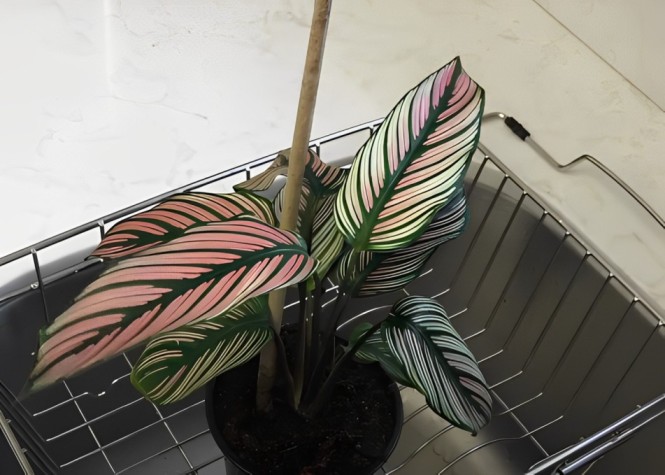
When it comes to feeding your Calathea WhiteStar, always abide by the directions on the fertilizer container. Less is sometimes more when it comes to feeding.
Best Location for growing
Your Calathea-WhiteStar should be kept close to a window that receives filtered, indirect light.
It should not be placed in direct sunlight since it might damage the foliage. Keep this plant away from draughts and chilly areas since it enjoys steady warmth.
It may also be kept content and healthy by spraying its leaves or using a humidity tray to create a humid environment.
Potting Requirements
Choose a pot with drainage holes at the bottom when potting your this plant to avoid waterlogging. To keep the soil constantly wet but not soggy, use a well-draining potting mixture that contains peat moss or coconut coir.
Every one to two years, repot your plant in the spring to replenish the soil and make sure it has enough room to develop. Usually, a slightly bigger pot will do.

Growth Habits
A gorgeous indoor plant with a modest growth rate is the Calathea-WhiteStar. It normally stands between one and two feet tall. Its lance- or paddle-shaped leaves have a distinctive white and green design that gives your environment a touch of class.
This plant has a propensity to cluster together as it grows, giving it a lush look. Maintain the right care settings, such as constant hydration and indirect light, to keep it healthy.
How to Prune
Calathea-WhiteStar pruning is easy and beneficial for maintaining the plant’s health. Find any leaves that are brown or broken, and clip them off close to the root using a clean pair of scissors or pruning shears. The plant can concentrate on new growth if these leaves are routinely removed.
To stop the spread of disease, avoid cutting healthy leaves and carefully clean your instruments. Your Calathea will always look its best with pruning!
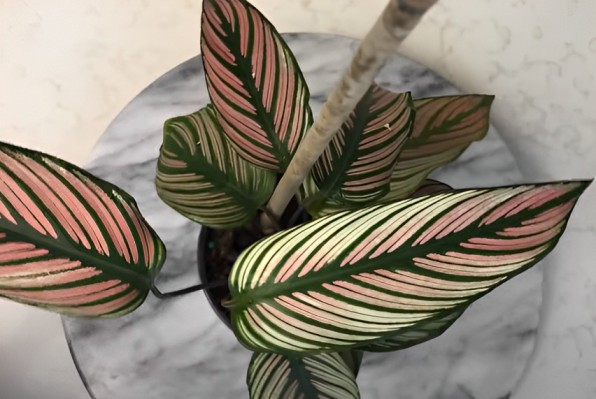
What To Do When You First Get Your Calathea WhiteStar
When you first bring home your Calathea White Star:
- Locate a cozy area: Put it in a space with good indirect lighting.
- Water with caution: Maintain a moderate moisture level in the soil; water when the top inch feels dry.
- Be patient; it could take some time for your plant to acclimatize; don’t worry if it seems a little picky at first.
- Verify for pests: Check the leaves for any unwelcome guests, such as spider mites, and gently wipe them off.
- Enjoy and watch: Show your new plant some TLC to see it thrive!
Propagation for Calathea Whitestar
- Choose a Healthy Plant: For propagation, use a mature, healthy Calathea White Star plant.
- Get Your Tools Ready: A pair of scissors or a sharp knife, as well as some pots filled with new potting soil, are required.
- Divide the plant: Carefully take it out of the pot while being careful not to harm the roots. Find roots that naturally divide or separate portions. There should be a few stems and sound roots in each division.
- Plant and Trim: Use your tool to carefully cut the divisions, making sure that each part has roots attached. Put these divisions into separate pots with potting soil that is well-draining.
- Water and Care: Make sure to give the freshly potted divisions plenty of water, and then put them somewhere with indirect light.
- Maintain a constant moisture level in the soil that is not wet. By spraying the plants or utilizing a humidity tray, you may maintain a high humidity level.
- Patience is Key The divisions’ establishment and growth into mature plants might take some time. Be patient and keep giving them the same attention you would provide to an adult Calathea White Star.
- Root Cuttings:
- You can also propagate Calathea White Star from root cuttings, although this method is less common:
- A node is a little bump where roots and stems originate. When cutting healthy, mature roots into parts, make sure each cutting contains at least one node.
- In pots with an appropriate potting mix, plant the root cuttings.
- Keep the soil continually wet and give them plenty of water.
- Keep the humidity high to promote root development.
- Leaf Cuttings:
- While leaf cuttings are less successful with Calathea species, it’s possible to try:
- Ensure that each portion of a healthy leaf has a vein or petiole connected.
- Put the leaf cuttings in pots filled with a mix that drains properly.
- To maintain high humidity, keep the soil just barely damp and cover the cuttings with a plastic bag or a plastic dome.
- Be patient since leaf cuttings may require more time to develop roots and become new plants.
Growth Rate
Slow Growth: Calathea White Star develops gradually.
In contrast to several other plants, it doesn’t grow swiftly.
Be patient while it advances; expect slow, steady growth.
Continue giving appropriate treatment for the greatest outcomes.
Repotting
- Repot your Calathea White Star in the spring or early summer, when it is actively developing, every two to three years.
- Upsize Moderately: Opt for a pot that is just a little bit bigger than the one you already have, leaving opportunity for growth but not so enormous as to hold on to moisture excessively.
- Use fresh soil and a potting mix with a peat foundation that drains properly to provide the roots adequate airflow.
- Be cautious while transferring the plant from its previous container to prevent harming the roots.
- Maintenance: After repotting, continue to take the normal precautions, keeping the plant wet and giving the right amount of sunlight and humidity.
Common Problems And Solution
Problem 1: Browning Leaf Edges
Solution:Typically, this occurs when the air is excessively dry. By sprinkling the plant, using a humidity tray, or putting a tiny humidifier nearby, you may raise the humidity. If necessary, tidy up the brown edges with a pair of scissors.
Problem 2: Yellowing Leaves
Solution: Yellow leaves may be an indication of inadequate drainage or overwatering. Before watering, let the top inch of soil dry out, and check to see that your container has drainage holes. Additionally, avoid letting the plant sit in its saucer with too much water.
Problem 3: Drooping Leaves
Solution: Underwatering is frequently the cause of drooping foliage on your Calathea plants. Make sure you have a regular watering plan and give it a healthy sip of water.
Problem 4: Curling Leaves
Solution:Too much direct sunshine or underwatering can cause leaves to curl. Increase your plant’s watering frequency and relocate it to a location with indirect light.
Problem 5: Pests
Solution: Pests like mealybugs and spider mites should be watched out for. To routinely remove the leaves, wipe them with a moist cloth. If the infestation is bad, apply an insecticidal soap.
Problem 6: Fading Colors
Solution:Your Calathea White Star may not be receiving enough indirect light if its vivid colours start to fade. Move it to a location with more light that has been filtered.
Overwatering or Underwatering
Your Calathea-WhiteStar may suffer if it is both over watered and under watered. Over watering can cause the leaves to wilt and decay, as well as the roots to rot. On the other side, the leaves may get dry and crunchy if you go underwater.
Check the soil frequently and water when the top inch feels dry to maintain your plant healthy. Your Calathea White Star will flourish if you can strike the correct balance.
Toxicity
Despite being beautiful, Calathea White Star can be harmful if consumed by people or animals. If chewed or consumed, the substances in its leaves have been shown to upset the stomach and induce drooling and discomfort. Place it out of the way of curious pets and kids to keep everyone safe.
For advice if accidental consumption happens, speak with a physician or a veterinarian. Take in its beauty, but treat it with caution.
Pests
- Spider Mites: tiny insects that harm leaves by weaving webs on them.
• Aphids: tiny insects that deform leaves by sucking plant fluids.
• Mealybugs: White, cotton-like bugs that sap plant juices.
• Fungus Gnats:The larvae of tiny flies that deposit their eggs in the soil damage roots.
• Prevention: Keep your plant clean, abstain from overwatering, and keep an eye out for these pests. If necessary, use a mild insecticidal soap.
Disease
Root rot may result from overwatering. Before watering, allow the top inch of soil to dry.
It’s too dry if the leaf edges are brown and crunchy. Make use of a humidity tray or mist the foliage.
Yellow leaves might be a sign of excessive sunshine. Place it somewhere more shaded.
Look for insects like spider mites; if you see any, clean the leaves with a moist towel.
Wilting or Drooping Leaves
Your Calathea White Star rotting or drooping leaves are typically an indication of thirsty roots. The plant need hydration! Keep the soil wet but not drenched by watering it sparingly.
Check the quantity of indirect light it receives as well; too much or too little might induce leaf drooping.
Calathea WhiteStar Care and Maintenance
Calathea WhiteStar, known for its striking foliage, requires specific care to thrive. To ensure its well-being, regular maintenance is crucial. When it comes to Calathea White Star entretien (care), pay close attention to any taches (spots) on its leaves.
Brown tips, also referred to as braune flecken (brown spots) and brown leaves, can indicate issues with humidity or watering. To propagate a healthy Calathea White Star, consider taking boutures (cuttings) and providing them with proper care.
Proper Calathea White Star crispy leaves care involves maintaining the right humidity levels and avoiding direct sunlight. Monitor its growth to ensure it reaches its optimal height. If you notice it’s not growing as expected, assess its environment and make necessary adjustments.
Common problems like browning leaves can often be resolved by adjusting the care tips, such as adjusting watering frequency and providing the right amount of humidity. Remember that Calathea White Star is a favorite among pet owners, but it’s essential to confirm whether it’s cat safe and not toxic to cats to ensure your furry friends remain healthy.
Calathea White Star Care Considerations in Different Regions
For Calathea White Star enthusiasts in regions like Australia and Canada, be mindful of the specific care needs that might vary due to different climates and environments. Nighttime care is essential as well, as the plant may exhibit unique behaviors in the dark, so consider the at night requirements.
Keeping a close eye on your plant’s health and addressing any issues promptly will help you maintain its beautiful foliage and enjoy the feuillage jaune (yellow leaves) contrasted by dark spots. With the right care, your Calathea White Star will thrive and reach its full größe (size), showcasing its giftig für katzen (toxic to cats) characteristics.
Conclusion
It all comes down to a few crucial elements, and taking care of your Calathea White Star may be a gratifying experience. Always keep the soil constantly wet, but not soggy, and modify your watering plan according to how dry the soil is. To keep your plant’s lush foliage, place it in bright, indirect light.
Also, be aware of humidity levels by spraying the leaves or using a humidity tray. Check often for typical problems like browning or yellowing leaves, pests, or illnesses, and take the necessary steps to remedy them right away. Your Calathea-WhiteStar will flourish if you adhere to these care instructions and keep showing off its lovely, eye-catching leaves for many years.
FAQs
How much water does a Calathea WhiteStar need?
It needs weekly waterings, allowing the top 2′ of soil to dry out partially.
What kind of soil does a Calathea WhiteStar need?
Another approach is to use a mixture of 50% potting soil, 20% orchid bark, 20% charcoal, and 10% vermiculite. the mixture, then.
How much light does a white star plant need?
The ideal light will receive medium to bright indirect light.
What temperature is good for Calathea WhiteStar?
Keep your Whitestar warm, between 65 and 80 degrees Fahrenheit (18 and 25 degrees), and give it the proper humidity level.
Is Calathea WhiteStar indoor or outdoor plant?
This plant is both indoor and outdoor plant and make sure temperatures don’t dip under 65°F (18°C)
What family is Calathea White Star in?
This plant belong to Marantaceae family

